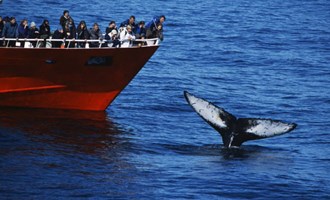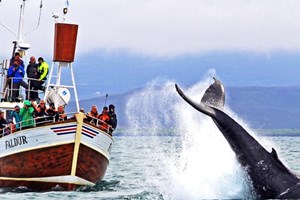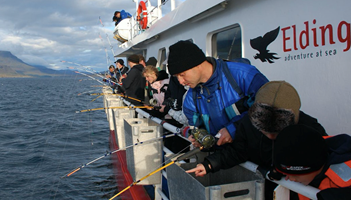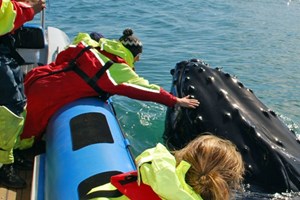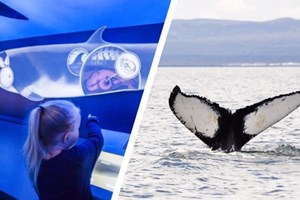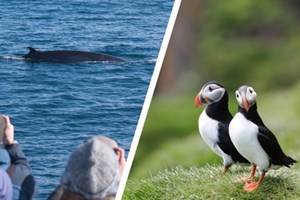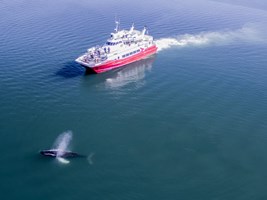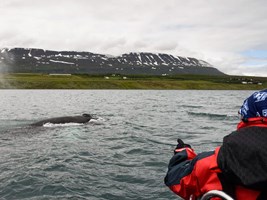Whales off the coast of Iceland
Whales are common off the coast of Iceland and Iceland is a great place for whale watching, a place where people have the opportunity to get up close to these massive mammals in their natural habitat. Whale watching is something that everyone should try if they intend to visit Iceland. There are 23 species of whales off the coast of Iceland, some are there for a short time each year while others stay there longer. The best time for whale watching is late spring until August.
Whale watching

Whale Watching tour with Elding
Whale watching in Iceland has grown enormously in recent decades and is very popular. Today, Iceland is one of the countries that have placed great emphasis on whale watching and Iceland is a very good place for those who want to see the whales and learn about their way of living in the wild. You can go almost everywhere for whale watching in Iceland. But the best place is probably Húsavík in north Iceland, usually called the home of whale watching in Iceland. It’s also good to go whale watching from Reykjavík, Snæfellsnes peninsula, Akureyri and other places as well.
The best time to go whale watching is during the summer months (May-August) when the whales are feeding and breeding. They are lively and often offer a good close range for photographing and inspection.
Whales in general

Whales are a diverse group consisting of baleen whales and toothed whales. They are different from the appearance and size can range from just over 2 meters and 130 kilograms to the size of 30 meters in length and nearly 190 tons. Whales are mammals that have adjusted very well to the life in the sea.
Baleen whales are filter feeders that usually are small animals (crustaceans) and plankton from the water, whales in the group are for example Minke whales, Long Fin, Blue whale and Humpback.
Toothed whales are the other group but they are predators and catch fish and other marine animals, an example of such whales are Sperm whales and Orca/Killer whales.
Many species of whales in the northern hemisphere travel thousands of miles every year to the cold and nutritious sea around Iceland during summer, they also mate late in summer or early fall. When fall and winter get closer, the whales return to the south where they give birth to their calves and feed them and wait until they are big enough to head north again.
In recent years, attempts have been made to fix a GPS positioning device to some whales to be able to collect information about their travel. You can see the gps path for a Humpback that got GPS positioning device in 2014 here. (http://www.hafro.is/hvalamerki/hnu1R.html?a=5)
Whales become puberty from three to ten years old. The female are usually fertile during the autumn and the gestation period is from 10 to 14 months. As for humans it’s usually one offspring that is dependent on his mother after birth, she feeds here offspring and protects. The females have on average of one calf every two to four years.
Whales communicate with high-frequency sounds that are different depending on the species, some are like a kind of singing. The Humpback whale is most known for great singing talent. It’s believed that whales use different sound in different situation as for communicate with each other as well as when they go hunting.
Most common baleen whales around Iceland are: Minke whales, Fin whale and Humpback whale.
For teeth whales the most common are Orca/Killer whales and various species of dolphins, such as White Beaked. Sperm whales are fairly common.
Whaling
Whaling has been conducted in the world for thousands of years. Back in the days whales were important food for people who lived nearby the sea. They were hunted for their meat but also bone and oil where used extensively. In particular, the use of whale oil was in the 18th and 19th centuries important fuel for lighting in many cities and towns around the world.
Nations that practiced whaling in the past were Norwegians, Japanese, Dutch and Americans, as well as native tribes in North America, Russia and Greenland hunted whales for food, and still do.
Whaling for economic purposes has however declined in recent decades and demand for whale meat is not the same as before. Today, the Japanese, Norwegians and Icelanders are hunting some whales for economic purposes.
Iceland has issued licenses on Minke whales and Fin whales every year but interest has been declining, the whales that are hunted are also used for scientific purposes, in an attempt to better understand the way of life of these remarkable animals.
Whales museum and exhibition

The Whale exception in Reykjavik
There are two great museums to see and learn about whales in Iceland, if you do not like going out to sea. It’s also ideal to visit the museums before or after going whale watching to get more information about their lifestyle and habitat.
The whale museum in Húsavík
There you can find a lot of information about whales, about where they live and how they live, they have whales skeletons that are interesting to see and give you a good sense of how big they are. As well as information about whale hunting and legends and tales.
The whale exception in Reykjavík
The whale exception in Reykjavík is another place to go, it is different than the whale museum in Húsavík, it focus more on the whales and how they look. It has real size models of all the most common whales around Iceland, as well as a lot of information about their way of life.
Common whales in Icelandic waters

Blue Whale - Balaenoptera musculus
Is the biggest mammal on Earth and belongs to a group of baleen whales. Visiting Iceland in spring and summer.
Length: Up to 30 meters
Weight: Up to 190 tons
Life expectancy: Up to 110 years
Minke whale - Balaenoptera acutorostrata
There are two different species of Minke whale, the Northern and the Antarctic (Southern).
Minke whales are the second smallest baleen whale, and the smallest around Iceland.
Length: Up to 11 meters
Weight: Up to 10 tons
Life expectancy: Up to 50 years
Fin whale - Balaenoptera physalus
Fin whale belongs to a group of baleen whales, fast swimmer and hard to hunt in the old days because of its speed.
Length: Up to 22 meters
Weight: Up to 70 tons
Life expectancy: Up to 90 to 100 years
Humpback Whale - Megapteranovaeangliae
The Humpback whale is a baleen whale, he has long fins and is thick and shorter than the other baleen whales. The best singer of the whales as well as being very playful.
Length: Up to 19 meters
Weight: Up to 48 tons
Life expectancy: Up to 50 years
Orca / Killer Whale - Orcinus orca
Sometimes called the Wolves of the sea, are sociable and stay together in family groups. Toothed whales. They are predators eating mostly fish, seals and even other whales. They have long and big back fin.
Length: Up to 10 meters
Weight: Up to 10 tons
Life expectancy: Up to 50 years
White beaked Whale - Lagenorhynchus albirostris and Lagenorhynchusacutus.
White Beaked whales are toothed whales. They are among the most ambitious dolphins, they travel long distance, coming up the coast of Iceland in the spring. Often travel in both small and big groups, they are very playful. Eating a lot of fish mostly cod.
Length: Up to 1.2 meters
Weight: Up to 370 kilograms
Life expectancy: Up to 25 years
Sperm whale - Physeter macrocephalus
Sperm whale's are the biggest toothed whales. They are great divers and can dive down to around 3 kilometer deep and submerged up to 45 minutes. They are predator and feeds on giant ink fish, tuna, sharks and octopuses. There are mostly young males and old males who visit Iceland during the summer, otherwise staying further southLength: Up to 20 meters
Weight: Up to 50 tons
Life expectancy: Up to 70 years
